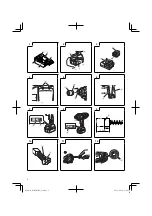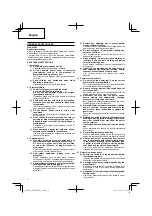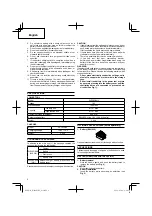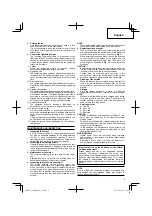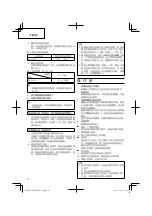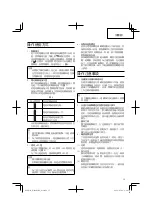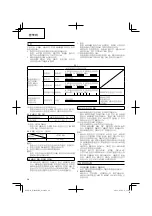
English
9
3. Holding the tool
Hold
the
impact
wrench
fi
rmly
with
both
hands.
In
this
case
hold
the
wrench
in
line
with
the
bolt.
It
is
not
necessary
to
push
the
wrench
very
hard.
Hold
the
wrench
with
a
force
just
su
ffi
cient
to
counteract
the
impact
force.
4. Con
fi
rm the tightening torque
The
following
factors
contribute
to
a
reduction
of
the
tightening
torque.
So
con
fi
rm
the
actual
tightening
torque
needed
by
screwing
up
some
bolts
before
the
job
with
a
hand
torque
wrench.
Factors
a
ff
ecting
the
tightening
torque
are
as
follows.
(1)
Voltage
When
the
discharge
margin
is
reached,
voltage
decreases
and
tightening
torque
is
lowered.
(2)
Operating
time
The
tightening
torque
increases
when
the
operating
time
increases.
But
the
tightening
torque
does
not
increase
above
a
certain
value
even
if
the
tool
is
driven
for
a
long
time.
(3)
Diameter
of
bolt
The
tightening
torque
di
ff
ers
with
the
diameter
of
the
bolt.
Generally
a
larger
diameter
bolt
requires
larger
tightening
torque.
(4)
Tightening
conditions
The
tightening
torque
di
ff
ers
according
to
the
torque
ratio;
class,
and
length
of
bolts
even
when
bolts
with
the
same
size
threads
are
used.
The
tightening
torque
also
di
ff
ers
according
to
the
condition
of
the
surface
of
workpiece
through
which
the
bolts
are
to
be
tightened.
When
the
bolt
and
nut
turn
together,
torque
is
greatly
reduced.
(5)
Using
optional
parts
The
tightening
torque
is
reduced
a
little
when
an
extension
bar,
universal
joint
or
a
long
socket
is
used.
(6)
Clearance
of
the
socket
A
worn
or
deformed
hex.
or
a
square-holed
socket
will
not
give
an
adequate
tightness
to
the
fi
tting
between
the
nut
or
anvil,
consequently
resulting
in
loss
of
tightening
torque.
Using
an
improper
socket
which
does
not
match
to
the
bolt
will
result
in
an
insu
ffi
cient
tightening
torque.
(7)
Tightening
torque
varies,
depending
on
the
battery’s
charge
level.
MAINTENANCE AND INSPECTION
1. Inspecting the socket
A
worn
or
deformed
hex.
or
a
square-holed
socket
will
not
give
an
adequate
tightness
to
the
fi
tting
between
the
nut
or
anvil,
consequently
resulting
in
loss
of
tightening
torque.
Pay
attention
to
wear
of
a
socket
holes
periodically,
and
replace
with
a
new
one
if
needed.
2. Inspecting the mounting screws
Regularly
inspect
all
mounting
screws
and
ensure
that
they
are
properly
tightened.
Should
any
of
the
screws
be
loose,
retighten
them
immediately.
Failure
to
do
so
may
result
in
serious
hazard.
3. Maintenance of the motor
The
motor
unit
winding
is
the
very
“heart”
of
the
power
tool.
Exercise
due
care
to
ensure
the
winding
does
not
become
damaged
and/or
wet
with
oil
or
water.
4. Inspecting the carbon brushes (Fig. 9)
The
motor
employs
carbon
brushes
which
are
consumable
parts.
Since
and
excessively
worn
carbon
brush
can
result
in
motor
trouble,
replace
the
carbon
brush
with
new
ones
when
it
becomes
worn
to
or
near
the
“wear
limit”.
In
addition,
always
keep
carbon
brushes
clean
and
ensure
that
they
slide
freely
within
the
brush
holders.
NOTE:
When
replacing
the
carbon
brush
with
a
new
one,
be
sure
to
use
the
Hitachi
Carbon
Brush
Code
No.
328481.
5. Replacing carbon brushes
Take
out
the
carbon
brush
by
fi
rst
removing
the
brush
cap
and
then
hooking
the
protrusion
of
the
carbon
brush
with
a
fl
at
head
screw
driver,
etc.,
as
shown
in
Fig. 11
.
When
installing
the
carbon
brush,
choose
the
direction
so
that
the
nail
of
the
carbon
brush
agrees
with
the
contact
portion
outside
the
brush
tube.
Then
push
it
in
with
a
fi
nger
as
illustrated
in
Fig. 12
.
Lastly,
install
the
brush
cap.
CAUTION:
Be
absolutely
sure
to
insert
the
nail
of
the
carbon
brush
into
the
contact
portion
outside
the
brush
tube.
(You
can
insert
whichever
one
of
the
two
nails
provided).
Caution
must
be
exercised
since
any
error
in
this
operation
can
result
in
the
deformed
nail
of
the
carbon
brush
and
may
cause
motor
trouble
at
an
early
stage.
6. Cleaning of the outside
When
the
impact
wrench
is
stained,
wipe
with
a
soft
dry
cloth
or
a
cloth
moistened
with
soapy
water.
Do
not
use
chloric
solvents,
gasoline
or
paint
thinner,
as
they
melt
plastics.
7. Storage
Store
the
impact
wrench
in
a
place
in
which
the
temperature
is
less
than
40°C,
and
out
of
reach
of
children.
NOTE:
Make
sure
that
the
battery
is
fully
charged
when
stored
for
a
long
period
(3
months
or
more).
The
battery
with
smaller
capacity
may
not
be
able
to
be
charged
when
used,
if
stored
for
a
long
period.
8. Service parts list
A:
Item
No.
B:
Code
No.
C:
No.
Used
D:
Remarks
CAUTION
Repair,
modi
fi
cation
and
inspection
of
Hitachi
Power
Tools
must
be
carried
out
by
an
Hitachi
Authorized
Service
Center.
This
Parts
List
will
be
helpful
if
presented
with
the
tool
to
the
Hitachi
Authorized
Service
Center
when
requesting
repair
or
other
maintenance.
In
the
operation
and
maintenance
of
power
tools,
the
safety
regulations
and
standards
prescribed
in
each
country
must
be
observed.
MODIFICATIONS
Hitachi
Power
Tools
are
constantly
being
improved
and
modi
fi
ed
to
incorporate
the
latest
technological
advancements.
Accordingly,
some
parts
(i.e.
code
numbers
and/or
design)
may
be
changed
without
prior
notice.
Important notice on the batteries for the Hitachi
cordless power tools
Please
always
use
one
of
our
designated
genuine
batteries.
We
cannot
guarantee
the
safety
and
performance
of
our
cordless
power
tool
when
used
with
batteries
other
than
these
designated
by
us,
or
when
the
battery
is
disassembled
and
modi
fi
ed
(such
as
disassembly
and
replacement
of
cells
or
other
internal
parts).
NOTE
Due
to
HITACHI’s
continuing
program
of
research
and
development,
the
speci
fi
cations
herein
are
subject
to
change
without
prior
notice.
000Book̲WR18DSHL̲Ara.indb 9
000Book̲WR18DSHL̲Ara.indb 9
2012/07/16 9:20:58
2012/07/16 9:20:58


